Tuesday 23 December 1941
 |
| Wrecked US Marine Corps Grumman F4F-3 Wildcat fighters at Wake Island on or after 23 December 1941. There are about seven planes in this view. Following standard practice at all forward airfields, parts from damaged planes were used to repair other planes. The plane in the foreground is "211-F-11," Captain Henry T. Elrod's mount which he used to sink Japanese destroyer Kisaragi (National Archives via US Naval History and Heritage Command 80-G-179006). |
Battle of the Pacific: With Vice Admiral William S. Pye, Acting Commander in Chief US Pacific Fleet, having recalled the relief force for Wake Island, there is little hope for the US Marines and civilian contractors stranded there on
23 December 1941. At 02:35, about 1500 Japanese marines land after a powerful preliminary bombardment. Supported by air strikes from aircraft carriers Hiryu and Soryu, the Japanese marines overwhelm the garrison.
 |
| A 1943 aerial photograph of Wake Island marked to show key points during the 23 December 1941 invasion of the island. The two Japanese destroyers used as landing craft are still beached off the island, and the Japanese have constructed an airfield (using US civilian contractors captured during the raid) nearby. |
The US marines destroy Japanese landing craft Patrol Boat No. 32 and Patrol Boat No. 33, which are beached, but they have no air support and their artillery quickly is silenced. The fighting rages through the morning, but the situation is hopeless. The US Marines have 49 dead, two missing, and 49 wounded overall during the siege. In addition, over 70 US civilian contractors perish and a dozen are wounded. Overall, the Japanese capture 433 American men at a cost of 144 Japanese casualties. A huge fraction of the US civilian contractors will be executed by the Japanese during the war.
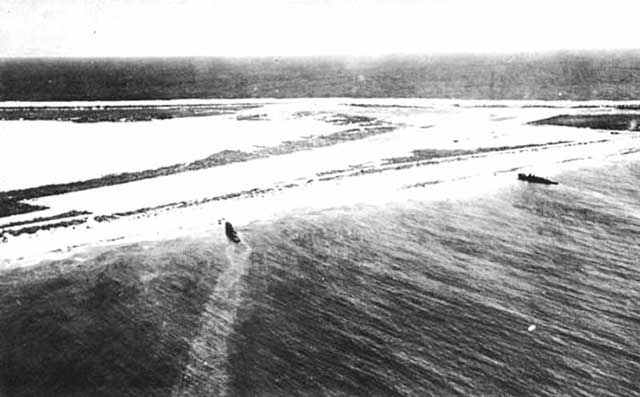 |
| HIJMS Patrol Boat No.32 (left) and Patrol Boat No.33 (right), badly damaged during the invasion of Wake Island on 23 December 1941 but which managed to reach shore and beach themselves (United States Navy or United States Marine Corps). |
While a major propaganda victory, the Japanese gain little by occupying Wake Island. They force the captured Americans to fortify the island, including bringing in an 8-inch (200 mm) naval gun, but the isolated location offers so few possibilities that the US Navy makes no plans to recapture it. In fact, its location on the route from Pearl Harbor toward Japanese possessions further west turns the island of Wake into the perfect live-fire training ground for US naval airmen and gunners. With so many US Navy ships in the vicinity, the Japanese find it impossible to supply the small garrison there with food, much less with airplanes or other offensive weapons. As an ideal training for US Navy pilots like future President George H.W. Bush, the US Pacific Fleet is content to simply keep an eye on it while pumping a few shells at the Japanese installations as ships pass on to more important destinations. The Japanese flag flies at Wake Island until 4 September 1945.
 |
| "Wake Island, December 23, 1941. Japanese troops pay homage to a memorial erected to unit commander Uchida, who was killed in the landing on Wake Island, 23 December 1941. Copied from a Japanese picture book. U.S. Marine Corps photograph." (National Museum of the U.S. Navy #USMC 315175). |
In Manila, Lieutenant General Douglas MacArthur, Commanding General US Army Forces Far East and a Field Marshal in the Filipino Army, notes the Japanese invasion force that landed just north of Manila on the 22nd and declares it an open city. The Japanese in Rosario advance ten miles (16 km) south toward Manila by dusk. The US forces begin withdrawing south into the Bataan peninsula. This is an easily defended region where the US Army has stored nearly one million US gallons of gasoline. The retreat is orderly and not made under Japanese pressure. Late in the day, a 7000-man Japanese force from the Ryukyu Islands lands in Lamon Bay. The US Army Air Force still has some B-17 Flying Fortresses at Del Monte Field on Mindanao, and they attack Japanese shipping in Lingayen Gulf, damaging a destroyer and a minesweeper. The Japanese send troops from Mindanao Island to land on Jolo Island in the Sulu Archipelago, indicating that they aren't too worried about the remaining US presence in the Philippines.
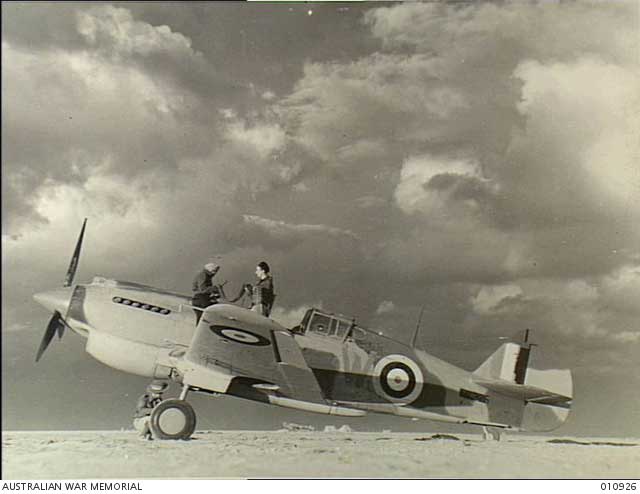 |
| "Western Desert. Armorers working on a [Curtiss] Tomahawk fighter aircraft of No 3 Squadron RAAF." 23 December 1941 (Australian War Memorial 010926) |
Japanese submarine attacks on US shipping off the west coast continue, with I-21 torpedoing and sinking 8272-ton US tanker Montebello four miles off of Cambria, California and later using its deck gun to damage 6418-ton tanker Idaho. Submarine I-17 uses its deck gun to damage 7038-ton American tanker Larry Doheny about 62 nautical miles southwest of Eureka, California. As experience in the Atlantic has proven in the war to date, tankers are extremely difficult to sink due to their compartmentalized construction. In addition, Japanese submarines I-71 and I-72 shell US-held Palmyra Island, which is about 960 nautical miles southwest of Honolulu.
 |
| Japanese artillery based on Jardine's Lookout in action, with Wong Nei Chong Gap in front of them. Late December 1941 (©IWM SIT3571). |
On Hong Kong Island, the Japanese have split the island in two and are gradually restricting the remaining British presence. The Canadian Royal Rifles, a unit that had only embarked for the territory on 27 October 1941, withdraws into Hong Kong's Stanley Peninsula to make a last stand. The fighting is extremely savage, and there are reports of Japanese atrocities.
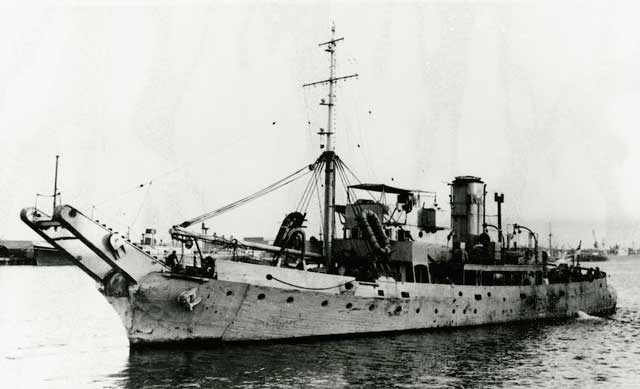 |
| HMAS Karangi. Commissioned into the Royal Australian Navy on 23 December 1941, the Karangi was the third Boom Defence Vessel constructed by Cockatoo Island Dockyard. It serves in the Australian Navy until 1964. |
The British remove Major-General David Murray-Lyon of the Indian 11th Infantry Division from his command on 23 December 1941 due to the unit's rocky withdrawal south toward Kuala Lumpur. He thus becomes the campaign's first scapegoat, but not the last. The Indian III Corps completes its withdrawal behind the Perak River after dark. The Japanese aircraft in the region shift their attention from attacking British airfields north of Singapore, all of which have been abandoned, to assisting ground troops.
 |
| One of the two Japanese landing craft beached at Wake Island on 23 December 1941. |
The war at sea is picking up quickly. On Borneo, the Dutch naval forces detect a Japanese naval convoy sailing from Miri for Kuching and send submarines to intercept it. HNLMS K XIV sinks Japanese Army transports Hiyoshi Maru and Katori Maru, while Hokkai Maru is beached to prevent it from sinking. Most of the Japanese troops get through to the target, however, and they take Kuching by mid-afternoon. The 15th Punjab Regiment retreats up the nearby river. During the night, Dutch submarine HNLMS K XVI torpedoes and sinks Japanese destroyer Sagiri about 30 miles north of Kuching, notching the first Allied submarine victory over a Japanese warship. However, the crew of K XVI doesn't have long to celebrate, as Japanese submarine I-66 spots it and sinks it with all hands shortly thereafter. Off Badoc, US submarine SEAL sinks 856-ton Japanese freighter Soryu Maru.
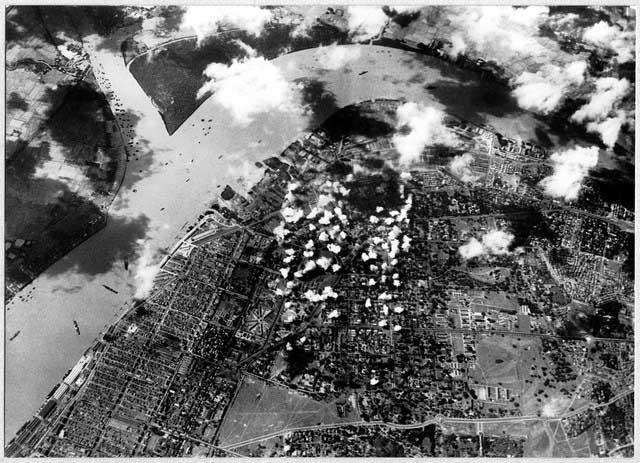 |
| Japanese photo showing the bombing of Rangoon on 23 December 1941. |
In Burma, 80 Japanese Mitsubishi Ki-21 bombers escorted by 30 fighters bomb Mingaladon and downtown Rangoon for the first time. Casualties are unknown but there are an estimated 2000 civilian deaths. The American Volunteer Group (AVG aka "Flying Tigers") and Royal Air Force Brewster Buffaloes intervene but cannot prevent the attack. The Japanese use both high explosive and incendiary bombs. Combined with a similar attack on 25 December 1941, the Japanese destroy 60% of the wooden buildings in the entire downtown area from Pazundaung to Ahlone. This bombing begins a desperate flight from Rangoon of Indians, Burmese, Anglo-Burmese, Europeans, Chinese, Karens, and others.
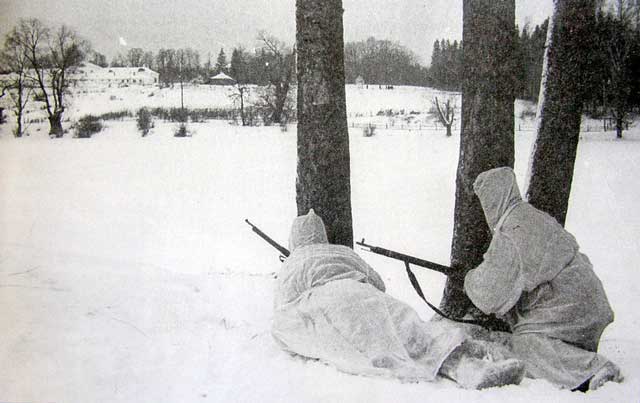 |
| Soviet scouts outside Moscow near Yasnaya Polyana, December 1941. The Red Army advance often involved soldiers like this attacking isolated German outposts where the Germans had taken over peasant buildings. Notice how well the Red Army men are dressed for operating outdoors, with felt boots and caps with earflaps. General Guderian had his headquarters in Yasnaya Polyana. |
Eastern Front: German withdrawals continue around Moscow. In General Guderian's Second Panzer Army, the 296th Infantry Division escapes from a potential encirclement and by falling back to the Oka River at Belev. Its neighbor, the 167th Infantry Division, is not as fortunate and is smashed by the Soviets. Guderian requests permission to take his entire front behind the Oka River, but Field Marshal Guenther von Kluge denies the request because of Hitler's "stand fast" order and cautions that further retreats cannot be made "under any circumstances" without the Fuehrer's permission.
 |
| Western Desert, Libya. 23 December 1941. This is known as the Graveyard of the Stukas, some of the German dive-bomber aircraft destroyed by the Allied Air Forces (Australian War Memorial MED0220). |
Battle of the Mediterranean: Much of the action is taking place at sea along the Axis supply routes to the Afrika Korps in Libya and the British convoys to Tobruk. The Royal Navy sends Convoy AT-5 to Tobruk, and that leads to a lot of action. U-559 torpedoes and sinks 3059-ton British freighter Shuntien east of Tobruk. It is carrying 850 mostly Italian prisoners of war and has a crew of seventy. Casualties are unclear because corvette HMS Salvia, which rescues as many people as it can, is lost itself on 24 December and virtually everyone on it perishes. So, ultimately, very few people on board the Shuntien ever set foot on land again. Meanwhile, convoy escorts Hasty and Hotspur use depth charges to sink U-79 off Bardia about 69 nautical miles (129 km) east of Tobruk. The U-boats crew is fortunate, however, as the Captain, three officers, and forty ratings and nobody perishes.
 |
| SS Shuntien, sunk on 23 December 1941 with great loss of life off Tobruk. |
On land, the British advance by XIII Corps comes to a halt due to stiffening Axis resistance and supply issues. The Germans are gradually consolidating their position in western Libya, so the Indian 4th Division takes Barce. The Germans at Antelat retreat to Agedabia under pressure from the British 7th Armored Division.
 |
| An early production model of the C-47 Skytrain transport under production at the Douglas Aircraft Company plant at Long Beach ca. 1941. Douglas produced 13 C-47s a day at this facility. (Library of Congress). |
US Military: Today is the first flight of the first C-47 Skytrain, 41-7722, the first DC-3 variant built specifically as a military transport. It flies at Daugherty Field, Long Beach, California. The US Army Air Force already has purchased hundreds of DC-3-type airplanes, most notably as the personal transport of the Chief of Staff of the USAAF, General Henry "Hap" Arnold, but those were civilian versions. The military version has a cargo door on the left side of the fuselage, a strengthened cargo floor, a navigator's Astrodome, and provisions for glider towing. The C-47 Skytrain generally is considered the most successful military transport ever.
 |
| SS Montebello at her launching at Eat San Pedro in 1921. Japanese submarine I-21 hits the Montebello, which had departed from Port San Luis early in the morning, with one torpedo on 23 December 1941 near Piedras Blancas Point (off Cambria, California). All 39 crewmen take to the boats as I-21 surfaces and fires with its deck gun. The tanker finally sinks bow first. Everyone survives. |
French Military: In a rare military land action in North America, Free French forces land on St. Pierre and Miquelon and seize them without much trouble. Vichy officials have been governing the islands off of Newfoundland until now. This eliminates the last Vichy French military presence in the Americas, as the French outpost at Martinique already has entered into an armistice agreement with the United States.
American Homefront: Californians feel increasingly threatened by the recent spate Japanese attacks just off the coast, and there aren't many US Army troops defending the coastline. Lieutenant General John DeWitt, Commanding General Fourth Army and also Commanding General Western Defense Command, decides it is time to impose some discipline. He induces California Governor Culbert Olson to ban the sale of liquor to any person in uniform except during "Happy Hour" and the evening, from 1800-2200.
 |
| A 1930s postcard showing a bronze statue by Louis Auguste Hiolin in the Park des Les Buttes Chaumont called "Au Loop." The statue portrays a young shepherd chasing a wolf away from his lambs. A 23 December 1941 article in Figaro notes that the Germans had seized the statue to melt it down. The statue has never been replaced but the pedestal remains in place, empty. It is a very pretty spot and many park-goers enjoy sitting on the pedestal. |
December 1941
December 1, 1941: Hitler Fires von Rundstedt
December 2, 1941: Climb Mount Niitaka
December 3, 1941: Hints of Trouble in the Pacific
December 4, 1941: Soviets Plan Counteroffensive
December 5, 1941: Soviets Counterattack at Kalinin
December 6, 1941: Soviet Counterattack at Moscow Broadens
December 7, 1941: Japan Attacks Pearl Harbor
December 8, 1941: US Enters World War II
December 9, 1941: German Retreat At Moscow
December 10, 1941: HMS Prince of Wales and Repulse Sunk
December 11, 1941: Hitler Declares War on US
December 12, 1941: Japanese in Burma
December 13, 1941: Battle of Cape Bon
December 14, 1941: Hitler Forbids Withdrawals
December 15, 1941: The Liepaja Massacre
December 16, 1941: Japan Invades Borneo
December 17, 1941: US Military Shakeup
December 18, 1941: Hitler Lays Down the Law
December 19, 1941: Brauchitsch Goes Home
December 20, 1941: Flying Tigers in Action
December 21, 1941: The Bogdanovka Massacre
December 22, 1941: Major Japanese Landings North of Manila
December 23, 1941: Wake Island Falls to Japan
December 24, 1941: Atrocities in Hong Kong
December 25, 1941: Japan Takes Hong Kong
December 26, 1941: Soviets Land in the Crimea
December 27, 1941: Commandos Raid Norway
December 28, 1941: Operation Anthropoid Begins
December 29, 1941: Soviet Landings at Feodosia
December 30, 1941: Race for Bataan
December 31, 1941: Nimitz in Charge
2020















No comments:
Post a Comment